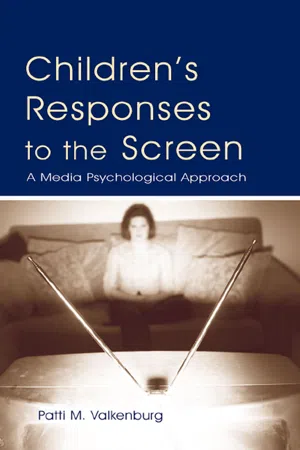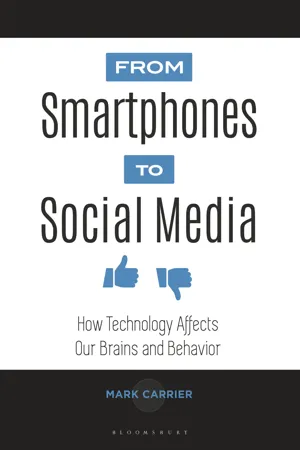Psychology
Media Influences on Aggression
Media influences on aggression refer to the impact of media content, such as violent video games, movies, and television shows, on aggressive behavior. Research in this area explores how exposure to violent media can desensitize individuals to violence, increase aggressive thoughts and emotions, and lead to aggressive behavior. Understanding these influences is important for addressing the potential negative effects of media on individuals' behavior.
Written by Perlego with AI-assistance
Related key terms
Related key terms
1 of 4
Related key terms
1 of 3
11 Key excerpts on "Media Influences on Aggression"
- eBook - ePub
The Social Psychology of Aggression
3rd Edition
- Barbara Krahé(Author)
- 2020(Publication Date)
- Routledge(Publisher)
Chapter 6 M edia violence and aggression In the public debate on aggression and violence, media influences are blamed by many people for the apparently increasing levels of aggression, especially among children and adolescents. A cursory and occasional sampling is sufficient to convince the everyday observer that television programmes are full of aggressive episodes, often of a highly violent nature, that are easily accessible even to young viewers. The same is true for movies, comic books, and, in particular, video games. In addition, surveys regularly show that children are exposed to violent media for substantial durations from an early age. These observations lead many people to believe that the portrayal of violence in the media affects the level of aggression in society. Some critics even argue that media consumption in general, irrespective of its aggressive content, contributes to aggression and antisocial behaviour. At the same time, the claim that violent media contents cause users to become more aggressive has been vigorously disputed, not only by users and the media industry, but also by some researchers in the field. The present chapter will review the current state of the debate on the link between media violence and aggression, whereby media violence is defined as showing or describing behaviour by media characters intended to cause harm, especially severe physical harm, to others. The discussion is guided by the general proposition that the effects of media use on social behaviour depend on the content of the media stimuli. As we saw in Chapter 2, observational learning plays a major role in the acquisition and persistence of aggressive behaviour. For this process to happen, the observed behaviour needs to be aggressive in nature - eBook - ePub
Children's Responses to the Screen
A Media Psychological Approach
- Patti M. Valkenburg(Author)
- 2004(Publication Date)
- Routledge(Publisher)
CHAPTER 3Media Violence and Aggression
Of all issues related to children and the media, the influence of violent entertainment on aggressive behavior has undoubtedly received most research attention. This chapter provides insight into the current state of the empirical research on this topic. Consisting of four sections, the first discusses the different types of effect studies that have been conducted, identifying their strong and weak points. The second section reviews the various theories that attempt to explain why media violence may effect aggressive behavior, such as the social learning theory, cognitive script theory, arousal theory, and desensitization theory. The third section focuses on differentiations in the effects of media violence, such as the characteristics in media productions that stimulate or reduce aggressive behavior, and the factors influencing children's susceptibility to media violence. The final section concentrates on how adults can modify or counteract possible adversive effects of media violence on children.FIVE TYPES OF RESEARCH ON THE EFFECTS OF MEDIA VIOLENCE
Public concern about the effects of media violence on aggressive behavior existed long before television was introduced. However, the empirical research that investigates whether there is a basis for this concern did not burgeon until the 1960s, when growing fear about increasing delinquency in American inner cities developed. Since then, numerous studies have been conducted into the impact of media violence on the aggressive behavior of children and young people.To understand and critically evaluate the research into the impact of media violence on aggressive behavior, it is necessary to overview the nature of the re-search that has been conducted. The empirical research into the impact of media violence can be classified into five types of studies: (1) laboratory experiments, (2) field experiments, (3) correlational studies, (4) causal-correlational studies, and (5) meta-analyses. I start this chapter with a discussion of each of these types of research. - Larry D. Rosen, Nancy Cheever, L. Mark Carrier, Larry D. Rosen, Nancy Cheever, L. Mark Carrier(Authors)
- 2015(Publication Date)
- Wiley-Blackwell(Publisher)
Note that the single episode cycle most directly speaks to aggressive outcomes occurring within a given moment. However, it should also be noted that each social encounter can influence distal processes, such as learning about consequences or changes in the individual’s predispositions to react aggressively. For example, when playing violent video games, aggression-related knowledge structures are learned, rehearsed, and reinforced. This leads to long-term changes in aggressive beliefs and attitudes (Bryant, Carveth, & Brown, 1981; Crick & Dodge, 1994; Dodge, 2010), aggressive perceptual and expectation schemata (Dill, Anderson, Anderson, & Deuser, 1997; Moller & Krahé, 2009), aggression-related scripts (Huesmann, 1988), and desensitization to aggression and violence (Carnagey, Anderson, & Bushman, 2007; Mullin & Linz, 1995). In essence, what develop are the underlying psychological aspects that together influence aggressive personality, which in turn influences the types of situations that the individual may experience in the future.Although violence in media has been the most heavily studied form of content, one should note that some video games clearly possess content that is not violent but also can influence thoughts, feelings, and behavior. For example, playing video games containing prosocial content leads players to increase helping behavior outside of the video game context (Greitemeyer & Osswald, 2010). For this reason, learning theories are best applied to understand the wider range of effects that video games can have beyond aggression. Similar to aggression, however, the literature devoted to learning is often fragmented into different levels of analysis, focusing on specific learning processes such as habituation, discrimination, classical conditioning, operant conditioning, observational learning, and cognitive and emotional learning. Although learning from games (or anything) can occur at each of these levels, they have also been integrated recently into a general learning model (Buckley & Anderson, 2006; Gentile, Groves, & Gentile, 2014). It is valuable to remember that basically every effect that video games can have on players is due to learning. People can learn from a single exposure to something, but they learn it especially well with repetition and rewards, both of which video games provide well.- eBook - ePub
- Miles Hewstone, Wolfgang Stroebe, Miles Hewstone, Wolfgang Stroebe(Authors)
- 2021(Publication Date)
- BPS Blackwell(Publisher)
At the cognitive level, media depictions of aggressive interactions work through a process of priming to increase the accessibility of aggressive thoughts and feelings. Exposure to aggression in the media may instigate the acquisition of new behaviours through imitation (Gentile & Gentile, 2008). Much of the aggression portrayed in the media is rewarded (e.g., winning extra points for running over a blind pedestrian in reverse gear, as in the racing game ‘Carmageddon II’) or at least goes unpunished (e.g., when a cartoon character is blown to pieces and quickly reassembled a moment later). In the long run, the repeated observation of violence in the media may affect aggression through the process of observational learning. Violent media characters are typically presented as strong, powerful and acting in pursuit of a good cause, making them appealing models (Bandura, 1983). The repeated observation of aggression that is rewarded and shown by attractive models promotes the development of aggressive scripts (Huesmann, 1998). Finally, at the level of arousal and affect, chronic exposure to media violence leads to habituation, which, in turn, reduces empathy with victims of real‐life violence. Habituation describes the process whereby the ability of a stimulus to elicit arousal becomes weaker with each consecutive presentation. The person gets used to it, and the stimulus loses its impact (Krahé, 2013b; Krahé, Möller, Huesmann, Kirwil, Felber, & Berger, 2011). FIGURE 9.9 Cartoon violence – aggression portrayed in the media often goes unpunished. Source: © Donna Day - eBook - ePub
Mass Media Effects Research
Advances Through Meta-Analysis
- Raymond W. Preiss, Barbara Mae Gayle, Nancy Burrell, Mike Allen, Raymond W. Preiss, Barbara Mae Gayle, Nancy Burrell, Mike Allen(Authors)
- 2006(Publication Date)
- Routledge(Publisher)
The importance of the findings can also be interpreted in the context of aggregation of effects (Eagly & Wood, 1994). Exposure to media violence may have a small to moderate impact on any single behavior, but the impact may be substantial when cumulated across multiple exposures and multiple social interactions. The research in our review typically exposed participants to only one or a few episodes of media violence. The cumulative impact across a lifetime of media exposure might plausibly be greater. Furthermore, if the form of media impact followed a nonlinear pattern, then media effects would only be apparent in cumulated data and would be captured inadequately by the one-shot exposure studies typical in our review (e.g., if an exposure threshold exists with media effects discernible only above some minimum level; McGuire, 1986). It is possible that the full impact of media violence is apparent when viewers interact with others. Aggregation across aggressive acts may also be required to document substantial media impact. Particularly if we assume that one person's aggression begets corresponding hostility in others (Kiesler, 1983; Leary, 1957; Orford; 1986), small increases in an individual's aggression may have significant impact across sequences of interaction with other people.To interpret effect size, we might also ask whether exposure to media violence is an important determinant of aggression in comparison with other known predictors. It is not possible to present a comprehensive literature review here, but we present some representative findings from the host of predictors of aggression. As an example of individual differences, the median sex difference in aggressive behavior is r = .19 (Bettencourt & Miller, 1996). A similar size effect is found in developmental research: Parents who use corporal punishment have children who are more likely to be nominated by peers as being aggressive (d = .36, Gershoff, 2002). As evidence of a situational factor, Bushman and Cooper's (1990) meta-analytic synthesis found that alcohol enhanced laboratory-based aggression (mean rs ranged from 0.12 to 0.29, depending on the type of control condition). Finally, well-conducted studies examining the effect of video game violence on aggression yield mean rs that range from .19 to .27 (Anderson et al., 2004). Thus the media effects documented in the present review are of a magnitude comparable to these other predictors of aggression.Yet media violence effects do not appear especially significant if we consider the macrosocial variables that have been used to account for aggregate, populationlevel indicators of aggression. It is easy to find substantial predictors of aggression in this literature. For example, Baron and Straus (1987) found that the reported incidence of rape across the United States was highly associated (r - eBook - ePub
- Barrie Gunter, Jill McAleer(Authors)
- 2005(Publication Date)
- Routledge(Publisher)
The modelling and disinhibition perspectives propose that instances of violence depicted in the mass media may be emulated by members of the audience. Although more than one psychological mechanism has been implicated in this type of media influence, the fundamental feature throughout is that media influence operates in one direction. The media act upon audiences and bring about changes in their character. There is little consideration given to the expectations of audiences when they approach the media or of how audiences may discriminate between different kinds of media content and different kinds of violent portrayal. One-off exposure to media violence may have little effect. Is there a tendency, however, for certain viewers to seek out violent material and to enjoy repeated exposure to it? Does this phenomenon, if it occurs, serve to reinforce pre-existing aggressive tendencies in the individual? Alternatively, do certain individuals turn to the media as a source of ideas about how to behave in problematic situations, and utilise television as a source of guidelines or ‘scripts’ about how to react in various situations?According to some media researchers, the relationship between viewing violence on television and the level of aggressiveness in young viewers builds over time, with some children and teenagers appearing to be more susceptible to develop a television dependency. Poorer academic achievers, those with less developed social skills and social networks, and those who fantasise about violence a lot all tend to display greater aggressiveness. Such children also tend to spend more time watching television. In addition, children who identify more strongly with aggressive television characters and perceive television violence as being more realistic also tend to display more pronounced aggressive tendencies. Thus, according to this social development model, a mixture of developmental factors seem to combine with television to promote aggressiveness.22An investigation of children’s reactions to the popular series Mighty Morphin Power Rangers - eBook - ePub
Applied Social Psychology
Understanding and Addressing Social and Practical Problems
- Jamie A. Gruman, Frank W. Schneider, Larry M. Coutts(Authors)
- 2016(Publication Date)
- SAGE Publications, Inc(Publisher)
Numerous experimental studies have demonstrated such a relationship between TV violence and aggressive behavior. A meta-analysis (i.e., a statistical procedure for assessing the overall results of numerous studies) of 230 experimental studies of media violence with more than 100,000 research participants in total found that exposure to media violence consistently resulted in higher levels of a variety of aggressive behaviors (Hearold, 1986; see also Paik & Comstock, 1994). However, it is important to remember that most of the experimental studies were conducted in a laboratory setting, and so the aggressive behaviors were “milder” than the aggression found outside the laboratory (Giles, 2003). For example, many studies involved giving a person an electric shock or a loud blast of an aversive sound to the victim’s ear. Although these behaviors obviously are not “nice,” they are certainly not as violent as an aggressive assault or a homicide. One limitation of the research on media violence is that it has focused nearly exclusively on TV and movie violence. However, when you play a typical video game as is the man in Figure 7.2, how many acts of violence do you view? Of course, the issue of video games is much more complex because you not only are watching the violence, but in many ways are committing it. Many early commentators were particularly worried about video games for this very reason—people were in some way actually engaging in the violence when playing a video game rather than simply viewing the violence (Bowman, 2016). Research has shown that playing—or even just watching—violent video games can have the same effects as watching TV violence (Anderson, 2004; Anderson, Gentile, & Buckley, 2007). This area of research has become extremely controversial with some researchers arguing that video games do not have any effect on aggressive behavior (Ferguson, 2015; Markey, 2015) - eBook - ePub
Television, Imagination, and Aggression
A Study of Preschoolers
- D. G. Singer, Jerome L. Singer, Jerome L. Singer(Authors)
- 2014(Publication Date)
- Routledge(Publisher)
6 Television-Viewing and Aggression Play ObservationsHow many parents might willingly introduce into their homes two neighborhood toughs who would daily demonstrate for their children physical fighting and violence as a way of resolving problems? It can be argued that, considering the remarkably high level of violent activity demonstrated on the television (Gerbner & Gross, 1976), regular exposure of children to this medium may be serving much the same effect as suggested in the fantasy question just raised. The possibility that widespread watching by children and youth is increasing the level of violence in American society continues to be the most controversial and emotionally arousing issue related to the television medium. Before turning to some of the findings of our current research report which bear on this subject, it may be useful to review briefly some of the major dimensions of the arguments and counterarguments concerning the link between television-viewing and acts of violence in children and adolescents.THEORIES OF AGGRESSION AND THEIR RELATIONSHIP TO TELEVISION
Two major alternative positions have dominated the thinking of behavioral scientists concerning the nature of aggression and violence during the twentieth century. The most popular and widely believed theory has been espoused by many clinically oriented psychiatrists, psychologists, or mental health workers as well as in the popular writings of ethologists like Lorenz (1966). This position has also appeared to be most accepted by the general public. It is the theory that aggression as a fundamental human drive or motive is at least partially satisfied by vicarious experience or symbolic expression such as the viewing of aggressive films, plays, or athletic contests. Such instinct or drive theories of aggression are traceable to the influence of McDougall (1908) and Freud (1920/1955). - Barrie Gunter(Author)
- 2016(Publication Date)
- Palgrave Macmillan(Publisher)
The studies that populate the research literature here adopt methodologies designed to test cause-effect hypotheses. The primary aim of researchers who use experiments is to demonstrate that a specific mediated violence experience can cause subsequent aggression to occur in the individuals being observed. This approach toward the investigation of video game violence derives from the behaviourist experiments of the 1960s and 1970s into film and television violence effects. These studies focused mostly on televised violence, and found that conditions could be created in the laboratory that would encourage individuals to deliver what they believed to be harmful or painful stimuli to another person. These conditions were established, in part, through the prior behaviour of the target of the participant’s aggression toward the participant designed to make the latter feel antagonistic which was designed.Conditions hypothesized to be conducive to the promotion of participant aggression also included exposure to specific controlled media violence episodes. This basic experimental design was adapted by researchers to investigate the potential trigger effects of video game violence. The experience of television violence in the experiments of an earlier generation was replaced by video game violence. Studies of this type were initially conducted in the mid-1980s. They can be differentiated in terms of whether they were carried out with children or adults, as well as in terms of the types of responses that were measured—behavioural, emotional arousal and cognitive. Some researchers also manipulated other mediating factors, such as whether participants played competitively or cooperatively with each other. We return to this topic in Chapter 10- eBook - ePub
From Smartphones to Social Media
How Technology Affects Our Brains and Behavior
- Mark Carrier(Author)
- 2018(Publication Date)
- Greenwood(Publisher)
The scientists do not even agree on whether they agree. Before widespread video game playing, television violence was a key concern of scientists and the public in general. A 1984 survey of researchers who study violence found 80% agreement on the claim that media violence causes aggression. However, more recently there is debate about whether scientists agree on the effects of VVGs. In addition to questioning the existence of a consensus on the topic among researchers, accusations of foul play in the world of science have been made. One research team claimed to have observed that “… some scholars actively and aggressively attempt to quell dissenting views, disparage skeptics, question the motives of those who disagree with them, and enforce a highly ideological view of this field” (Elson & Ferguson, 2014). And the national organization of psychologists has changed its stance over the years. The leading society of practicing psychologists in the United States—the American Psychological Association (APA)—has had inconsistent views with respect to the topic. When media violence came before the U.S. Supreme Court, the APA declined to get involved on the basis that the research did not give a clear picture. Years later, in 2017, the APA published work from a task force on violent video gaming. The task force, after conducting their own meta-analyses of recent research studies (published between 2009 and 2013), came to the conclusion, among others, that VVGs decreased empathy and desensitized people to violence. As with other meta-analyses, the task force found small but statistically significant effect sizes.The in-fighting among scientists has led to interesting intellectual attacks, such as levying a list of psychological insults against each other. The pro-VVG/aggression link camp wonders why critics do not accept that VVGs are a factor in youth aggression. After all, there are clear, statistically significant, effects from the meta-analyses, and there is a logical and compelling understanding of how VVGs could cause aggression (the GAM). That camp concludes that there must be psychological reasons for the researchers’ absence of belief in the link, or what this camp calls “denial.” Two such reasons offered are a need for cognitive consistency and desensitization. The psyche wants to maintain a consistent set of beliefs (cognitive consistency), so evidence that goes against one’s views or one’s behaviors will be denied. For instance, researchers who grew up playing video games—even violent ones—might not want to accept that video games are damaging. Also, as years of violent media have been generated for consumers and as the media—not just video games—have become more violent, the public (including scientists) may have become unable to perceive the actual violence in violent media. The other camp has countered by pointing out the hostile behavior of their opponents, asking if media violence research can cause aggression. - eBook - ePub
Television and the Aggressive Child
A Cross-national Comparison
- L. Rowell Huesmann, Leonard D. Eron, L. Rowell Huesmann, Leonard D. Eron(Authors)
- 2013(Publication Date)
- Routledge(Publisher)
On the other hand, one could argue equally convincingly that the arousal fostered by television and film violence is an unpleasant consequence that serves as a negative reinforcer. In this case, the desensitized heavy violence viewers would be expected to behave more aggressively than those not desensitized. Confusion between these two processes is evident in the writings of communication researchers, some of whom argue that television is making children hyperactive by “overloading” them with stimulation (Halpern, 1975), whereas others claim television is anesthetizing children (Winn, 1977) by overloading them with stimulation. Still a third alternative is suggested by the recent research of Tannenbaum (1980) and Hayes et al. (1980) on the self-reinforcing properties of aggression. If we adopt the viewpoint that there is an optimal level of arousal that each individual finds most satisfying, then it follows that aggressive behavior might be used to generate desired levels of self-arousal. Because aggressive behavior of necessity produces heightened arousal, the desensitized violence viewer might behave more aggressively in order to achieve the desired level of arousal. Yet, once the higher level of arousal is achieved, the most likely behaviors to be emitted are those most readily retrievable from memory, i.e., the dominant responses (Zajonc, 1965). If these are aggressive responses, then aggression continues. Such a model provides a role for arousal both as a precursor and consequence of aggression.An Information-Processing Model
One of the problems with evaluating any of the aforementioned theories is that the exact psychological processes involved often have been poorly specified. One way to surmount this problem is by adopting an information-processing model in which processes elaborated by cognitive psychologists are used to explain the learning of aggression. Recently, a number of researchers have adopted this approach (Berkowitz, 1974, 1984; Huesmann, 1982; Huesmann et al., 1983; Huesmann & Eron, 1984; Turner & Fenn, 1978). We have hypothesized that social behavior is controlled to a great extent by cognitive scripts, schemas, and strategies that have been stored in memory and are used as guides for behavior. These strategies must be encoded, rehearsed, stored, and retrieved in much the same way as are other strategies for intellectual behaviors. These strategies might be closely associated with specific cues in the encoding context, or might be abstractions un-connected to specific cues. By encoding
Index pages curate the most relevant extracts from our library of academic textbooks. They’ve been created using an in-house natural language model (NLM), each adding context and meaning to key research topics.
Explore more topic indexes
Explore more topic indexes
1 of 6
Explore more topic indexes
1 of 4










